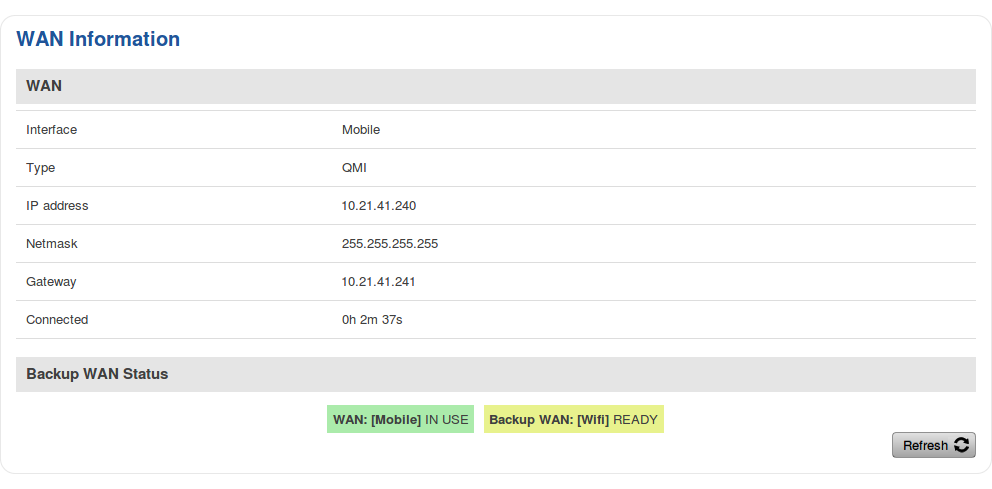RUT850 Network: Difference between revisions
No edit summary |
dsdsadsa |
||
| Line 2: | Line 2: | ||
| name = RUT850 | | name = RUT850 | ||
| series = RUT8xx | | series = RUT8xx | ||
| mobile = | | mobile = s4g | ||
| file_mobile = Networking_rutxxx_manual_network_mobile_information_4g_v2.png | | file_mobile = Networking_rutxxx_manual_network_mobile_information_4g_v2.png | ||
| file_wan = Networking_rut8xx_manual_network_wan_information_v1.png | | file_wan = Networking_rut8xx_manual_network_wan_information_v1.png | ||
}} | }} | ||
Revision as of 11:52, 2 March 2020
Main Page > EOL Products > RUT850 > RUT850 Manual > RUT850 WebUI > RUT850 Status section > RUT850 NetworkSummary
The Network page contains information related to the device's networking features. This chapter is an overview of the Network page in RUT850 devices.
Template:Networking rutxxx manual network mobile s4g
WAN
The WAN section displays information about the Main and Backup WAN connections. The figure below is an example of the Mobile page:
| Field | Description |
|---|---|
| Interface | WAN type. Possible values are:
|
| Type | Connection type or protocol. The value displayed in this field is dependent on used WAN type. Possible values are:
|
| IP address | Router's WAN IP address |
| WAN MAC | MAC address of the WAN network interface controller (WiFi radio). This field is only visible if main WAN is set to WiFi |
| Netmask | A netmask is used to define how "large" a network is by specifying which part of the IP address denotes the network and which part denotes the device |
| Gateway | Gateway of the default route - an IP address through which the router reaches the Internet |
| DNS | DNS servers used by the main WAN connection |
| Connected | Currently used WAN connection uptime |
| Backup WAN Status | Displays the router's current WAN failover status |
| Refresh | Refreshes all information fields in the page |
WAN settings can be customized via the Network → WAN page.
Wireless
The Wireless section displays information about wireless connections and associated WiFi stations.
Wireless Information
The figure below is an example of the Wireless Information section:
| Field name | Description |
|---|---|
| Channel | Currently used channel. In most countries there are 13 WiFi channels on the 2.4 GHz band (14 in Japan) to choose from |
| Country Code | Indicates currently used country code (SO/IEC 3166 alpha2 country codes as defined in ISO 3166-1 standard) |
Wireless Status
The Wireless Status section contains information about Wireless Access Points. The figure below is an example of the Wireless Status section:
| Field name | Description |
|---|---|
| SSID | The broadcasted SSID (Service Set Identifier) of the wireless network |
| Mode | Connection mode. Can either be Access Point (AP) or Client. In AP mode others can connect to this router's wireless connection. In client mode router connects to other wireless networks |
| Encryption | The type of WiFi encryption used |
| Wireless MAC | The MAC (Media Access Control) address of the access point radio |
| Signal Quality | The signal quality between router's radio and some other device that is connected to the router |
| Bit rate | The maximum possible physical throughput that the router's radio can handle. Bit rate will be shared between router and other possible devices which connect to local Access Point (AP) |
Associated Stations
The Associated Stations section contains information about devices that are connected to Wireless Access Point. The figure below is an example of the Associated Stations section:
| Field name | Description |
|---|---|
| MAC address | Associated station's MAC (Media Access Control) address |
| Device Name | Currently connected device name |
| Signal | Received Signal Strength Indicator (RSSI). Signal's strength measured in dBm |
| RX rate | The rate at which packets are received from associated station |
| TX rate | The rate at which packets are sent to associated station |




